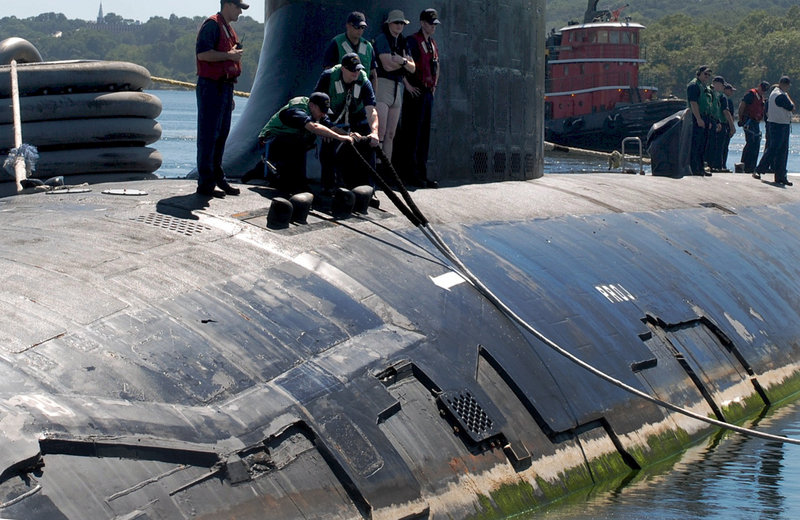KITTERY – The USS Virginia shed pieces of its sonar-absorbent skin while on patrol, giving the submarine’s hull a pockmarked appearance as it arrived for repairs at Portsmouth Naval Shipyard.
The submarine could become easier to detect by enemy sonar if it lost too much of the special coating. But the Navy insists that the sub never lost enough of the material to rise to that level and that it has moved aggressively to fix the problems in newer models of nuclear-powered attack submarines.
“We’ve been aware of the issues, we’re making improvements in the process, and we’re seeing results already,” said Alan Baribeau, spokesman for the Naval Sea Systems Command in Washington, D.C. There has been “no measurable impact on the ship’s performance,” he said.
Since the Navy took delivery of the Virginia in 2004, six others like it have been built and put into service.
During the summer, the Pentagon’s director of test and evaluation described a November 2009 review that found the finish peeling off in big swatches “up to hundreds of square feet.”
The most serious problems for the so-called anechoic coating have been limited to three of the first four subs in that class, the Navy said. The coating on the hull of the Virginia will be repaired during a regularly scheduled 14-month overhaul at Portsmouth Naval Shipyard.
The USS Virginia was off-limits to public viewing last week. But there were several missing pieces visible on the 377-foot-long sub when it arrived in Kittery on Sept. 1. The repair process includes cutting away any loose pieces of coating before replacing the material, the Navy said.
Cmdr. Timothy Salter, the sub’s skipper, declined to comment.
The material is likened to the coating on fighter jets and bombers that absorb radar’s electromagnetic waves; the anechoic tiles on submarines absorb sound waves from sonar.
They help to provide stealth to modern submarines.
“If you have a significant portion of a submarine’s exterior surface lacking sound-absorbent material, it’s at greater risk of being detected and tracked in a way that can compromise its survivability,” said Loren Thompson, a defense analyst with the Lexington Institute.
While the Navy has used anechoic tiles for years, it instituted a new process with the USS Virginia in which the ship is coated with a “special hull treatment,” Baribeau said. It’s described in some literature as a rubber-like substance, but the Navy won’t reveal details because it’s classified.
Problems with the coating on the USS Virginia were noted in 2007. The Navy immediately began working on changes to the application process, he said.
All told, the USS Virginia, USS North Carolina and USS Texas each lost 5-7 percent of their special hull coatings, the Navy said. The amount of coating peeling away has been reduced to less than 2 percent on the USS New Mexico and USS New Hampshire. Data on the newest sub in the class, USS Missouri, isn’t yet available.
Norman Polmar, a naval historian, author and analyst, agreed that the loss of part of the special coating isn’t catastrophic. And he sympathized with the engineering difficulties in finding a substance that can withstand salt water, rapidly changing water pressure and extreme cold.
But he questioned why the Navy didn’t have a handle on the problem. “We’ve been using anechoic coatings for almost 50 years you’d hope that we could get it right,” he said.
Send questions/comments to the editors.



Success. Please wait for the page to reload. If the page does not reload within 5 seconds, please refresh the page.
Enter your email and password to access comments.
Hi, to comment on stories you must . This profile is in addition to your subscription and website login.
Already have a commenting profile? .
Invalid username/password.
Please check your email to confirm and complete your registration.
Only subscribers are eligible to post comments. Please subscribe or login first for digital access. Here’s why.
Use the form below to reset your password. When you've submitted your account email, we will send an email with a reset code.